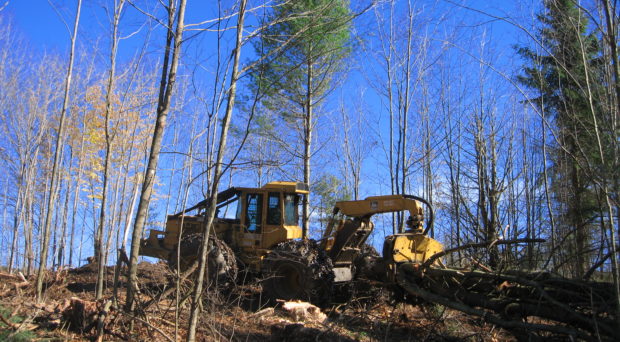
The challenge
我们面临气候变化紧急情况。在其他解决方案中,减少对大气的净碳排放量将需要增加可再生能源的使用,包括森林生物能。
The material left behind when logging (or “felling”) is a source of feedstock for bioenergy production but is currently under-utilized because it is expensive to remove and process.
这种“收获残留物”通常由叶子,树枝,树枝和树顶组成,但可能包括死亡和无法实现的树木,在伐木过程中没有剩下的没有经济价值的树木,或者被移除以进行森林健康或站立式转换。(此外,芬兰使用树桩,尽管这在其他地方并不常见。)
The issue

但是,使用收获残留物减少化石燃料的使用只是会造成环境降解的新问题吗?
收获残留物包含维持土壤质量所需的营养和有机物;它可以保护土壤免受伐木设备的物理破坏,并沿水道沿河岸区域确保水质;它为各种生物多样性提供食物和栖息地,从微生物和真菌到鸟类和大型哺乳动物。
Guidelines for how and when to remove appropriate amounts of harvest residues are foundational in ensuring that bioenergy is environmentally sustainable.
Although typically applied at the forest site level, they are nested within a larger context of other governance mechanisms, such as legislation, regulation, trade standards and certification.
The work
A group of forest scientists from around the world with experience in environmental impacts research within the bioenergy sector set out to write a definitive review of existing forest biomass harvesting guidelines as an aid to future guideline development.
在迅速变化的气候和能源政策时,这尤其重要,这可能会刺激更多地使用森林收获残留物。
成立了来自11个国家的16人组成的团队,他们成立了10种不同的语言,并找到了32个指南,其中涵盖了北美和欧洲的42个司法管辖区,另一种在东南亚。
通过这些,我们创建了一个易于访问的电子表格,其中包含直接报价,向森林经理,设备操作员和其他人提供指示或指示,以确保收获残留物的去除措施在环境上是可持续的。
详细的报价数据是通过逻辑主题分组和子组组织的,并总结了发现以进行高级比较。
调查结果
Overall, we found that, collectively, guidelines addressed biodiversity, soil, water quality, carbon, and social values – although any individual guideline might not cover all these topics.
北美和欧洲之间的担忧有所不同。在北美,生物多样性比欧洲更多,也许反映了不同数量的自然与管理森林以及社会态度。
同样,在北美,更多的水质也可能是由于1970年代开始,这可能是为保护许多美国以保护水质而创建的“最佳管理实践”指南的结果。
The earliest environmental concerns over harvest residue removal focused on soils, which have been researched extensively since the 1970s compared to other environmental values.
Not unexpectedly, guidance was often detailed and extensive, and there was general agreement on what constitutes “sensitive soils” between North America and Europe.
这些定义范围从“保护敏感土壤”的简单声明到识别土壤类型,其中一些包括图表避免土壤的地图。
还有一些人使用营养预算模型来识别与维持未来增长所需的残留萃取清除更多的营养。
但是,在北美通常禁止的残渣方法上存在明显的差异,但通常不在欧洲。
Likewise, guidance on compensatory application of ash from biomass combustion and fertilizer to return nutrients removed in harvest residue was almost non-existent in North America compared to Europe, which has a longer history of intensive silviculture, including fertilization.

Carbon is just beginning to be considered within forest biomass harvesting guidelines, and will no doubt become more prevalent in the future, given current trends.
However, site-level impacts on carbon stocks are relatively small compared to larger landscape and global-level questions regarding the overall net benefits of bioenergy using life-cycle approaches to carbon accounting.
As with carbon, there are fewer guidelines related to social impacts than there are for environmental impacts, and more for Europe than North America, particularly for preservation of archaeological, historical, and cultural sites.
The future
Overall, guidelines for harvest residue removals cover a wide range of topics, and vary in the depth with which topics are covered.
挑战仍然存在,尤其是其中的相对较少的经验领域数据基于指南:研究价格昂贵,而收获的森林需要很长时间才能重新生长。
科学必须支持指南的发展,但是操作经验和监测结果也起着重要作用,应在“通过执行”的自适应管理过程中结合使用,随着新知识的可用性,对准则进行了修订。
Some guidelines even state the date by which they must be revised, which speaks to the reality that change is an inevitable part of guideline development and application.
The imperative for revision can only become greater as the impacts of climate change on forested landscapes (wildfires, insects, disease, windthrow, etc.) add another layer of complexity to sustainable forest management.
注释